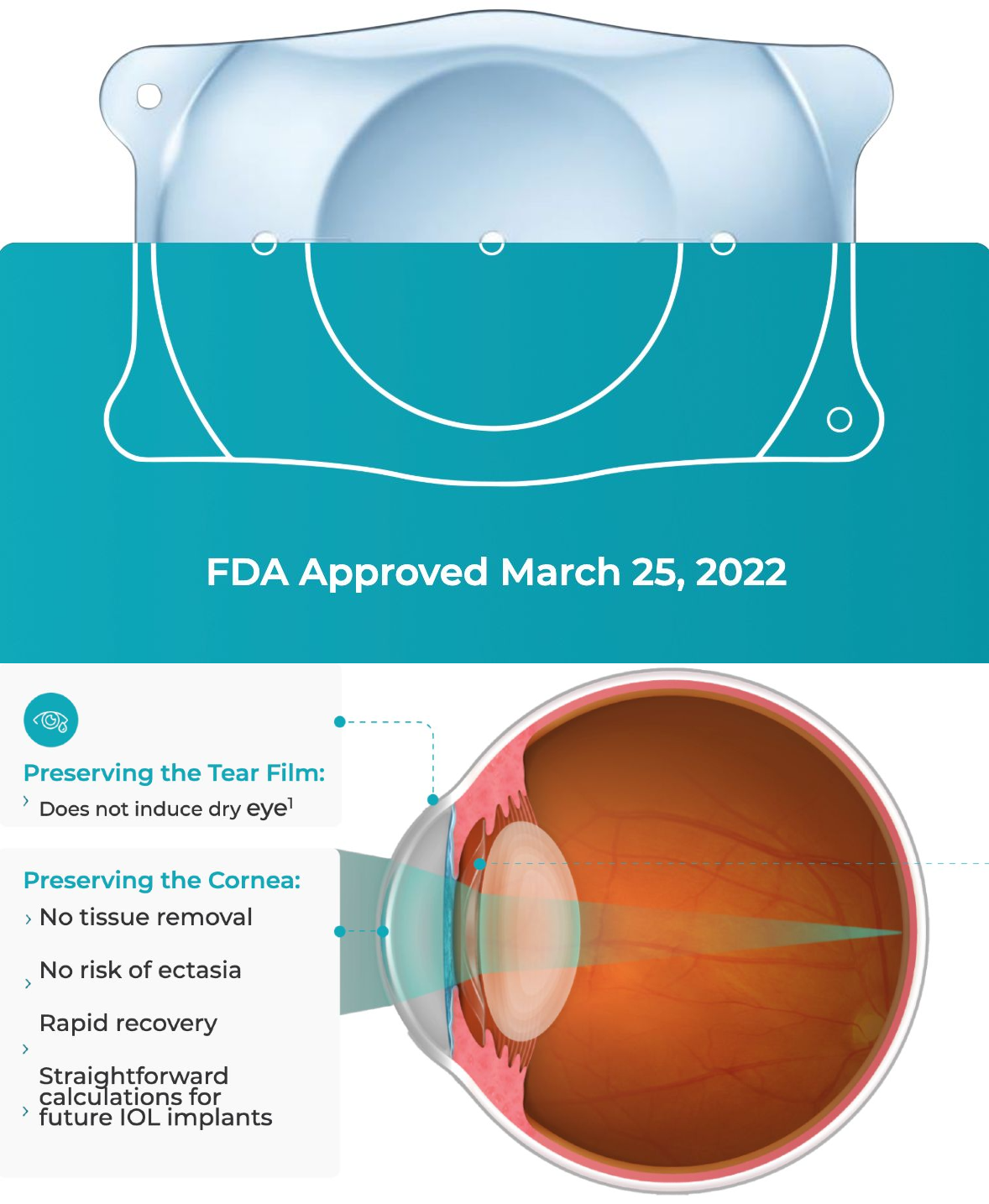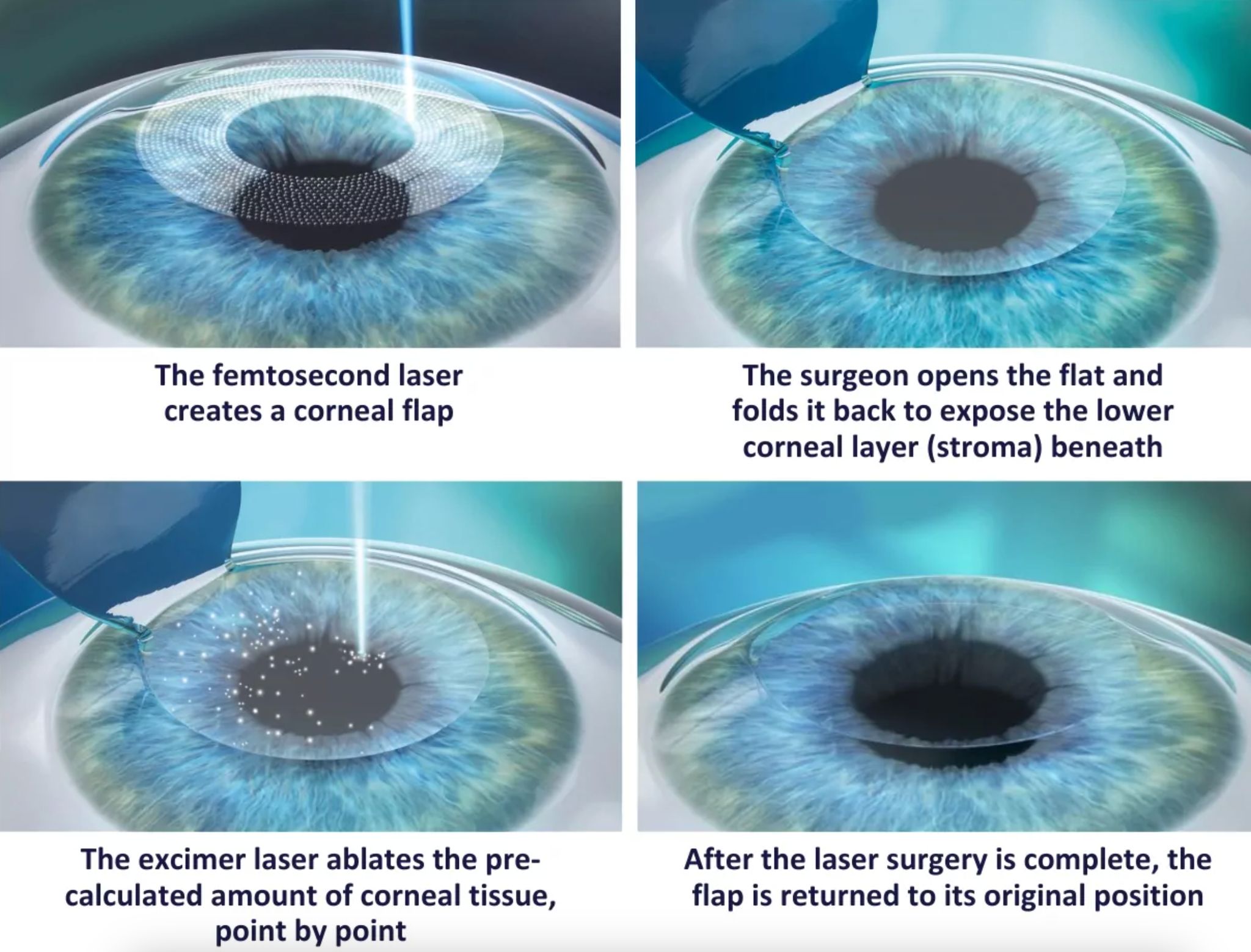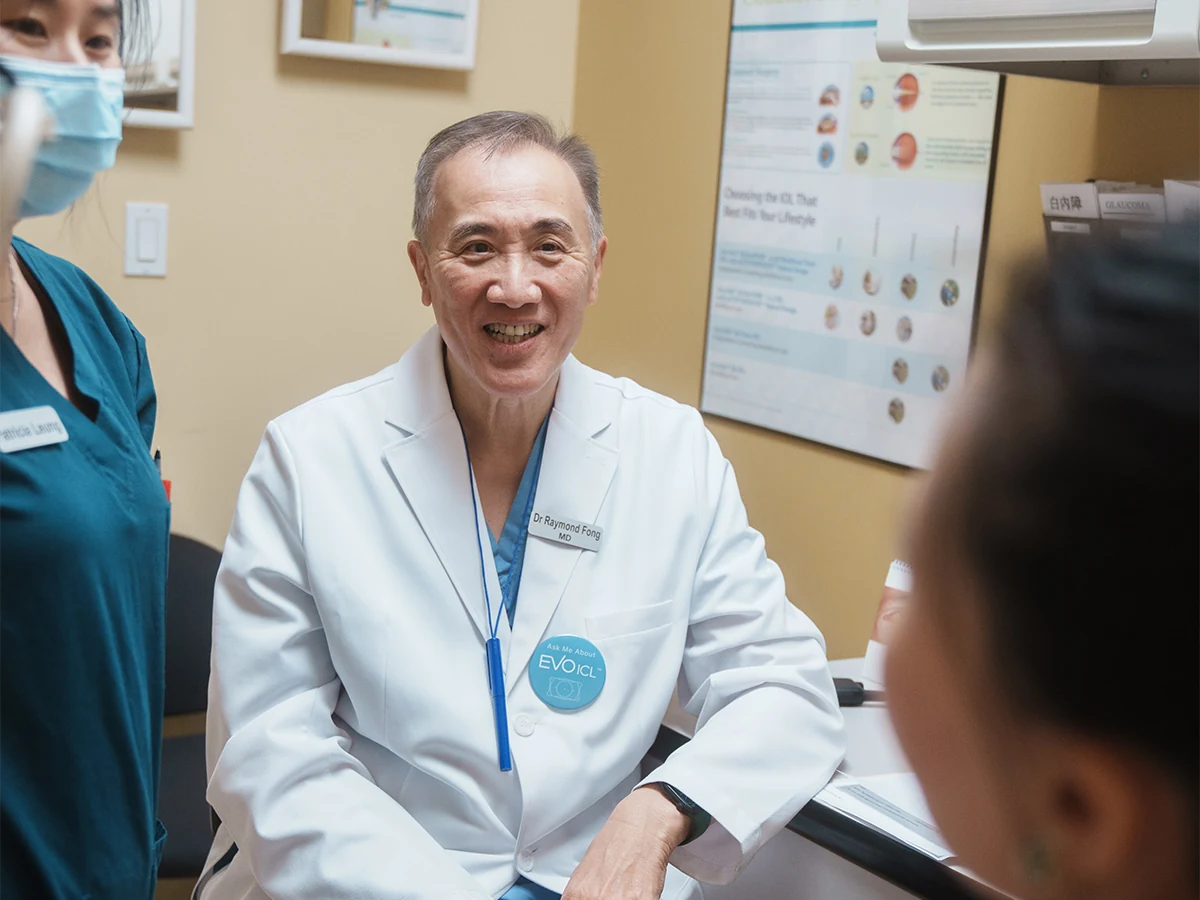FAQ – EVO ICL (Implantable Collamer Lens)

1. What is EVO ICL? What are its benefits? How is it different from LASIK?
EVO ICL (Implantable Collamer Lens) is a permanent, implantable lens designed to correct nearsightedness (myopia) and astigmatism without removing corneal tissue. The Collamer® material is biocompatible and has been safely used in eyes for over 30 years. Think of it as a contact lens implanted inside the eye, providing long-term vision correction.
Key Features of EVO ICL:
• Corrects myopia from -3.00D to -20.00D
• Corrects astigmatism up to -4.00D
• No corneal tissue removal —Ideal for patients with thin or irregular corneas
• Removable – Unlike LASIK, the lens can be taken out or replaced if needed
• UV protection & enhanced night vision
EVO ICL is not only an excellent alternative for those who are not good candidates for LASIK, but also an ideal choice for individuals seeking a premium vision correction solution with reversible and long-lasting results.
Key Features of EVO ICL:
• Corrects myopia from -3.00D to -20.00D
• Corrects astigmatism up to -4.00D
• No corneal tissue removal —Ideal for patients with thin or irregular corneas
• Removable – Unlike LASIK, the lens can be taken out or replaced if needed
• UV protection & enhanced night vision
EVO ICL is not only an excellent alternative for those who are not good candidates for LASIK, but also an ideal choice for individuals seeking a premium vision correction solution with reversible and long-lasting results.
2. Is EVO ICL suitable for patients with high myopia?
Yes! EVO ICL is specifically designed for moderate to severe myopia and can correct prescriptions ranging from -3.00D to -20.00D, making it an ideal solution for patients who are beyond the treatment range of LASIK. It is especially beneficial for high myopia patients with thin corneas, who may not be eligible for laser vision correction.
3. Is EVO ICL surgery safe? Can the implanted lens last a lifetime?
Yes, EVO ICL is an FDA-approved procedure with an excellent safety record. The lens is made from Collamer®, a biocompatible material that has been safely used in the eye for over 20 years. It does not cause dry eye symptoms, making it an excellent option for patients who experience dryness with other vision correction methods.
The latest EVO lens features a central port (KS-Aquaport®), which enhances the natural flow of aqueous humor, reducing the risk of increased intraocular pressure (IOP). Thanks to this design, the incidence of cataract formation after EVO ICL implantation is virtually zero, and IOP remains stable over time.
The implanted lens is intended to last a lifetime, but if necessary, it can be safely removed or replaced. According to clinical studies, 99.4% of EVO ICL patients reported they would choose the procedure again.
The latest EVO lens features a central port (KS-Aquaport®), which enhances the natural flow of aqueous humor, reducing the risk of increased intraocular pressure (IOP). Thanks to this design, the incidence of cataract formation after EVO ICL implantation is virtually zero, and IOP remains stable over time.
The implanted lens is intended to last a lifetime, but if necessary, it can be safely removed or replaced. According to clinical studies, 99.4% of EVO ICL patients reported they would choose the procedure again.
4. How long does it take to see clearly after EVO ICL surgery?
Most patients experience sharp vision within 24 to 48 hours, though the full stabilization process may take a few weeks. Some mild glare or halos may occur initially but usually subside after 6 months. Patients are advised to rest their eyes on the day of surgery, and most can resume normal activities in the next one or two days.
5. How much does EVO ICL cost? Is it more expensive than LASIK?
The cost of EVO ICL at Raymond Fong Eye Care starts at $9,000 for both eyes, regardless of whether you have astigmatism. This is more expensive than LASIK, which starts at $3800 for both eyes, because EVO ICL involves a custom-made implantable lens and requires specialized surgical expertise for optimal results.
To make the procedure more accessible, we offer interest-free financing options and our Clear Vision Guarantee, ensuring long-term vision stability and peace of mind
To make the procedure more accessible, we offer interest-free financing options and our Clear Vision Guarantee, ensuring long-term vision stability and peace of mind
6. Is Evo done in the office or a laser center ?
Unlike some other surgeons, Dr Fong does this surgery in a fully certified JCAHO surgical center as opposed to an office setting. This ensures that the procedure is done under the safest and cleanest environment.
7. What is the difference between getting EVO ICL in China vs. the U.S.?
In China, the version of this procedure uses the EVO ICL lens, while in the U.S., the latest version EVO+ ICL is available.
Key advantages of getting EVO+ ICL in the U.S.:
Larger optic zone – Reduces glare and halos, especially at night.
Better for larger pupils – Provides improved visual quality.
Newest technology – EVO+ ICL is the latest upgrade, which is not yet approved in China.
For patients looking for the most advanced vision correction technology, choosing EVO+ ICL in the U.S. provides the best long-term results.
Also in China , there are other versions of the EVO made by other companies that are not approved in the United States. The US has the highest standards to insure patient safety.
Key advantages of getting EVO+ ICL in the U.S.:
Larger optic zone – Reduces glare and halos, especially at night.
Better for larger pupils – Provides improved visual quality.
Newest technology – EVO+ ICL is the latest upgrade, which is not yet approved in China.
For patients looking for the most advanced vision correction technology, choosing EVO+ ICL in the U.S. provides the best long-term results.
Also in China , there are other versions of the EVO made by other companies that are not approved in the United States. The US has the highest standards to insure patient safety.
FAQ – LASIK Surgery

1. Is LASIK surgery safe? What are the risks?
LASIK is an FDA-approved procedure with a strong track record of safety and effectiveness since 1999. It has been performed on millions of patients worldwide with an extremely high success rate.
LASIK can effectively treat:
• Nearsightedness (myopia): Up to -12.00 diopters
• Farsightedness (hyperopia): Up to +6.00 diopters
• Astigmatism: Up to ±6.00 diopters
However, like any surgical procedure, LASIK does carry some risks. The most common side effect is temporary dry eyes, which usually improves over time with proper post-operative care. There may also be some glare and halo at night, which also diminishes with time. Both these side effects are much less common now with the newest advanced lasers and software .
Serious complications are extremely rare, especially when the procedure is performed by an experienced surgeon using advanced technology. At Raymond Fong Eye Care, we utilize state-of-the-art LASIK technology to minimize risks and ensure the highest level of precision and safety for our patients.
LASIK can effectively treat:
• Nearsightedness (myopia): Up to -12.00 diopters
• Farsightedness (hyperopia): Up to +6.00 diopters
• Astigmatism: Up to ±6.00 diopters
However, like any surgical procedure, LASIK does carry some risks. The most common side effect is temporary dry eyes, which usually improves over time with proper post-operative care. There may also be some glare and halo at night, which also diminishes with time. Both these side effects are much less common now with the newest advanced lasers and software .
Serious complications are extremely rare, especially when the procedure is performed by an experienced surgeon using advanced technology. At Raymond Fong Eye Care, we utilize state-of-the-art LASIK technology to minimize risks and ensure the highest level of precision and safety for our patients.
2. How long does it take to recover from LASIK? When can I resume normal activities?
Most patients experience noticeable vision improvement within 24 hours after LASIK, and many return to work the next or in two day. However, it takes a few weeks for vision to fully stabilize. During this time, it’s normal to have mild fluctuations in clarity. Full recovery varies by individual, but most patients can resume normal daily activities within a week, with a follow-up appointment to monitor healing progress.
3. When can I wear makeup, exercise, or swim after LASIK?
• Makeup: Avoid eye makeup for at least one week to prevent particles from irritating the healing cornea.
• Exercise: Light exercise can be resumed after 2-3 days, but avoid high-impact sports for at least two weeks to prevent accidental eye injury.
• Swimming: Pools, hot tubs, and open water swimming should be avoided for at least four to six weeks to reduce the risk of infection and irritation from salt or chlorine . If you wear goggles for swimming, you can resume in two weeks
• Exercise: Light exercise can be resumed after 2-3 days, but avoid high-impact sports for at least two weeks to prevent accidental eye injury.
• Swimming: Pools, hot tubs, and open water swimming should be avoided for at least four to six weeks to reduce the risk of infection and irritation from salt or chlorine . If you wear goggles for swimming, you can resume in two weeks
4. What is Contoura LASIK?
Contoura LASIK is an advanced, topography-guided LASIK procedure that provides higher precision and better visual outcomes than traditional LASIK, especially for people with high prescriptions. It customizes the laser treatment based on the unique curvature of your cornea, correcting not only nearsightedness and astigmatism but also improving contrast sensitivity and night vision. At Raymond Fong Eye Care, we offer the latest Contoura Vision technology to ensure superior results for our patients.
5. Can LASIK results regress? Will I need an enhancement procedure?
LASIK results are long-lasting for most patients. In very rare cases, some people may experience vision regression over time. This is influenced by factors such as natural aging and surgical precision.
More frequently , it is not regression, but some mild progression of the myopia that may occur.
At Raymond Fong Eye Care, we minimize this risk by offering:
1. Unmatched surgical precision: Dr. Fong has performed one of the highest numbers of LASIK procedures in New York, using the most advanced laser technology with regular software updates to ensure accuracy. Many of our patients who had LASIK 20+ years ago still maintain clear vision today.
2. Clear Vision Guarantee: As part of our commitment to long-term patient care, we offer a lifetime enhancement guarantee. As long as you come in for annual eye check-ups, if you ever experience significant vision regression or progression, we will provide a free enhancement procedure. Though rare, this ensures that you continue to enjoy clear vision for life.
More frequently , it is not regression, but some mild progression of the myopia that may occur.
At Raymond Fong Eye Care, we minimize this risk by offering:
1. Unmatched surgical precision: Dr. Fong has performed one of the highest numbers of LASIK procedures in New York, using the most advanced laser technology with regular software updates to ensure accuracy. Many of our patients who had LASIK 20+ years ago still maintain clear vision today.
2. Clear Vision Guarantee: As part of our commitment to long-term patient care, we offer a lifetime enhancement guarantee. As long as you come in for annual eye check-ups, if you ever experience significant vision regression or progression, we will provide a free enhancement procedure. Though rare, this ensures that you continue to enjoy clear vision for life.
6. How much does LASIK cost?
LASIK pricing varies based on individual vision needs, including your prescription strength and corneal characteristics. At Raymond Fong Eye Care, LASIK starts at $3800 for both eyes. During your consultation, we will assess your vision and provide a personalized quote. Financing options are available to make the procedure accessible to more patients.
RLE FAQ

1. What is RLE surgery? How is it different from cataract surgery?
Refractive Lens Exchange (RLE) is a vision correction procedure where the eye’s natural lens is replaced with a premium intraocular lens (IOL) to correct presbyopia, farsightedness, nearsightedness, and astigmatism.
While RLE is technically similar to cataract surgery, the main difference is timing—RLE is performed before the lens becomes cloudy, making it an elective procedure for patients who want to reduce dependence on glasses or contacts.
At Raymond Fong Eye Care, we specialize in multifocal and advanced technology lenses, which we believe offer the most complete solution for patients who want both clear distance and near vision without glasses.
While RLE is technically similar to cataract surgery, the main difference is timing—RLE is performed before the lens becomes cloudy, making it an elective procedure for patients who want to reduce dependence on glasses or contacts.
At Raymond Fong Eye Care, we specialize in multifocal and advanced technology lenses, which we believe offer the most complete solution for patients who want both clear distance and near vision without glasses.
2. What is a multifocal lens, and how does it help patients who over 50 to get rid of glasses?
A multifocal intraocular lens (IOL) is an advanced artificial lens implanted during RLE (or cataract surgery) that allows patients to see clearly at multiple distances—near, intermediate, and far—without the need for glasses.
Unlike monofocal lenses that focus at just one distance, multifocal lenses use special optical zones or light-splitting technology to provide a full range of vision, eliminating the need for reading glasses and distance glasses. If you want to enjoy clear vision at all distances without glasses, multifocal lenses offer an excellent solution.
Unlike monofocal lenses that focus at just one distance, multifocal lenses use special optical zones or light-splitting technology to provide a full range of vision, eliminating the need for reading glasses and distance glasses. If you want to enjoy clear vision at all distances without glasses, multifocal lenses offer an excellent solution.
3. What age is best for RLE? Can it treat presbyopia, astigmatism, and high myopia?
RLE is typically recommended for patients aged 45 and older, especially those experiencing presbyopia (age-related loss of near vision) or who are no longer ideal candidates for LASIK monovision correction.
In certain cases, patients in their early 40s may consider RLE earlier, particularly if their profession or lifestyle places high demands on visual performance at multiple distances, or if they have significant refractive errors that can’t be corrected with other procedures.
In certain cases, patients in their early 40s may consider RLE earlier, particularly if their profession or lifestyle places high demands on visual performance at multiple distances, or if they have significant refractive errors that can’t be corrected with other procedures.
4. Will RLE give me 20/20 vision? How much will my reading vision improve?
While every eye is unique, many of our patients achieve 20/20 for distance but more importantly 20/20 for near vision after RLE. Our goal is what we call "20 Happy"—meaning vision that fits your lifestyle and brings true satisfaction.
With multifocal or extended depth-of-focus lenses, most patients can read, use digital devices, and drive without glasses. The vast majorities enjoy sharp distance and near vision and no longer need reading glasses after surgery.
With multifocal or extended depth-of-focus lenses, most patients can read, use digital devices, and drive without glasses. The vast majorities enjoy sharp distance and near vision and no longer need reading glasses after surgery.
5. How much does RLE cost?
RLE (Refractive Lens Exchange) is a permanent vision correction solution, and its cost reflects the use of premium intraocular lens technology and long-term visual benefits. At Raymond Fong Eye Care, pricing starts at $9,000, with interest-free financing options available—starting as low as $14 per day over a 24-month plan.
Unlike LASIK, which does not correct age-related lens changes, RLE replaces your natural lens with an artificial one, meaning you will never develop cataracts in the future. It’s a one-time investment in lifelong clear vision with a durable, permanent lens designed to last a lifetime.
Unlike LASIK, which does not correct age-related lens changes, RLE replaces your natural lens with an artificial one, meaning you will never develop cataracts in the future. It’s a one-time investment in lifelong clear vision with a durable, permanent lens designed to last a lifetime.
6. Is RLE safe? Are there any complications?
Yes, RLE is a safe and well-established procedure, nearly identical to cataract surgery—one of the most successful and commonly performed surgeries in the United States, with over 4 million procedures annually.
Complications are the same as cataract surgery. These are rare especially when the procedure is performed by experienced surgeons using modern technology and premium intraocular lenses.
At Raymond Fong Eye Care, we offer our Clear Vision Guarantee—a commitment to helping you achieve vision you’re truly happy with. If any enhancements are needed after your procedure, we provide a complimentary laser touch-up to ensure your vision meets your expectations.
Complications are the same as cataract surgery. These are rare especially when the procedure is performed by experienced surgeons using modern technology and premium intraocular lenses.
At Raymond Fong Eye Care, we offer our Clear Vision Guarantee—a commitment to helping you achieve vision you’re truly happy with. If any enhancements are needed after your procedure, we provide a complimentary laser touch-up to ensure your vision meets your expectations.